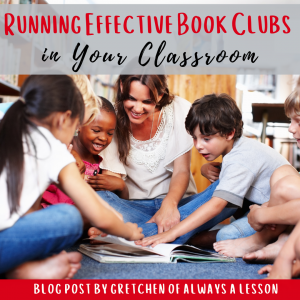Running Effective Book Clubs in Your Classroom
Book clubs are a great way to foster a love of reading in students while increasing their ownership in the learning process. It is a strategic instructional decision that requires strong classroom management skills to orchestrate. This is because book clubs are small groups of students reading a common text and discussing the content, meaning multiple groups can be occurring at the same time without the teacher facilitating. Of course, teachers can run book clubs by meeting with one group at a time and guiding the discussion. However, the most effective book clubs are self-run by students. This means they are engaging in peer discussion without an adult facilitator as well as reading on their own during independent reading.
This post will discuss setting up book clubs and supporting students during them.
Setting up Book Clubs
 Begin by exposing students to the idea of book clubs by doing a whole class learning experience. Select one text that all students will be reading. Set expectations for how students are to complete assignments and come together for discussions. Students will need to practice expectations for a month or so before they are capable of reading and learning on their own with their peers.
Begin by exposing students to the idea of book clubs by doing a whole class learning experience. Select one text that all students will be reading. Set expectations for how students are to complete assignments and come together for discussions. Students will need to practice expectations for a month or so before they are capable of reading and learning on their own with their peers.
Keep an eye on students that did well during the whole group book club learning experience. These particular students will be a great first group to engage in a self-run book club. 4 to 5 students in a group allows for them to connect together and form a bond. When groups are small enough, students feel safe to take risks and grow their skills. Students in a book club need to be on similar reading levels to avoid frustration in the text being too easy or hard to comprehend and engage in discussions.
Once you have created your first group, meet with them to select the book. Walk through the book and together create a reading schedule- what will students read and by when? Map out the reading assignments for the entire book and carve out two peer discussion meetings per week to discuss what was read and takeaways. As the teacher, check in on them once a week. During this check in, observe how students engage in discussion and provide feedback. This group can complete self-reflections for accountability purposes, detailing their contributions (as well as their peers’) during the book club.
Continue whole group book clubs with the rest of the class. As students show they are ready to engage in self-run book clubs, teachers can begin adding new groups. They can use the same text as other self-run book clubs in the classroom but meet in their own small group. Or students can use a different text better aligned to their reading level.
Some students may never be ready to engage in self-run book clubs. They may require heavy facilitation from the teacher to stay on track or make sense of the text. Either way, all students can engage in book clubs in a format that best supports their learning.
Supporting Students during Book Clubs
Just because students are engaging in a self-run book club, does not mean the teacher is off the hook for teaching. Teachers can pull a small reading group focused on a reading skill, facilitate a book club discussion, or work 1:1 with students to collect informal data. This is all while keeping eyes and ears open on students engaging in self-run book clubs around the classroom. Holding students accountable for maintaining established expectations determine how long students can engage in book clubs. The earned autonomy for students is a privilege and students need to be reminded of this.
As teachers are walking around leaning in and listening to peer discussions, they can incorporate a book club interruption. All students can pause their discussions, and turn their attention to the teacher. Calling out strong reading and peer discussion behaviors model to the rest of the class what they could be doing in their own groups. It celebrates student learning while motivating others to grow their skillset.
If students are struggling to keep conversation going with peers, teachers can provide sentence stems. Helping students move away from sharing their own thoughts at their peers, and responding appropriately to their peer while adding on their own thoughts is a challenge. Sentence stems act as a bridge to facilitate the conversation without the teacher having to do it. Over time, this support can be eliminated as students no longer need them.
[bctt tweet=”The goal of book clubs is not to finish the book. It is to help students be more reflective reading and engaged in deep, relevant peer discussions. ” username=”gschultek”]
Additional Resources
The resources below will provide more context for effectiveness.
- See how I used book clubs in my classroom here.
- If you are transitioning from doing novel studies in your classroom to self-run book clubs, learn more here.
- Read more here to better understand the shift in literacy instruction from a balanced approach to one that is more phonics based, providing a structure to seamlessly weave in book clubs.
If you are need of resources to help you become an even stronger teacher or coach, browse these printable and digital options. Check out my instructional coaching must-haves here. Don’t forget to catch up on other helpful blog posts as well!
GO BE GREAT!

